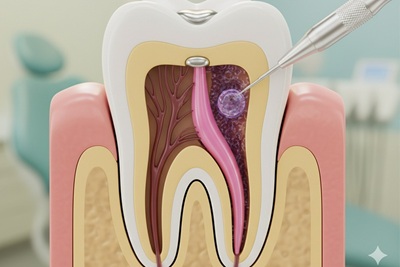Understanding Root Canal Therapy and Why It’s the Best Way to Save Your Tooth
Thu, Oct 2nd, 2025
There are few phrases in dentistry that evoke the same level of anxiety and discomfort as "root canal." Decades of misinformation and dramatic depictions in pop culture have painted Root Canal Therapy (RCT) as a painful, dreadful procedure—a final, undesirable frontier in dental care.
At Arnold Dentistry, we hear this fear every day. But here is the critical truth we want every patient in Brandon, FL, to understand: Root Canal Therapy is not the cause of pain; it is the cure.
In modern dentistry, a root canal is a virtually pain-free procedure that is the gold standard for treating deep infection, and it is the only way to save a natural tooth that has been severely damaged on the inside. It’s a powerful, restorative solution that eliminates suffering and preserves your smile for a lifetime.
If you have been told you need a root canal, or if you are experiencing severe tooth pain, let us walk you through the reality of this procedure, demystify the process, and explain why it is always the superior choice over extraction.
The Root of the Problem: When is a Root Canal Necessary?
To understand a root canal, you must first understand the anatomy of a tooth.
The outermost layer is the tough, protective enamel. Beneath that is the softer dentin. At the very core of your tooth is the dental pulp—a soft tissue mass containing nerves, blood vessels, and connective tissue. This pulp is essential for a tooth’s development, but once a tooth is fully mature, it can survive without it, drawing nourishment from the surrounding tissues.
A root canal is required when this pulp tissue becomes infected or inflamed. This usually happens due to:
- Deep Decay: A cavity is left untreated, allowing bacteria to bore through the enamel and dentin until they reach the pulp chamber
- Trauma: A crack, chip, or severe blow to the tooth creates an opening for bacteria to enter the pulp
- Repeated Dental Procedures: Extensive or repeated work on a tooth can irritate the pulp over time
The Warning Signs
The severe, persistent, and often throbbing pain associated with a tooth infection is caused by inflammation inside the enclosed space of the pulp chamber. When the nerve is exposed to bacteria and swelling, it signals intense distress.
Common symptoms that indicate a root canal may be necessary include:
- Persistent, severe toothache: Pain that wakes you up at night or interferes with your daily routine.
- Prolonged Sensitivity: Pain or throbbing that lingers after hot or cold foods are removed.
- Swelling: Tenderness or swelling in the gums surrounding the tooth.
- Abscess: A small, pimple-like bump on the gum that may occasionally drain.
If you ignore these signs, the infection will not heal on its own; it will spread, potentially leading to a dangerous abscess, bone loss in the jaw, and even systemic health issues.
Root Canal Therapy: A Step-by-Step Guide
The primary goal of Root Canal Therapy is simple: to stop the infection and remove the source of the pain, all while keeping the physical structure of your natural tooth intact.
Modern advancements have transformed the procedure, making it highly efficient, sterile, and—most importantly—comfortable.
Step 1: Diagnosis and Anesthesia
Before the procedure begins, Dr. Arnold will take an X-ray to confirm the diagnosis and determine the extent of the damage. The affected tooth and the surrounding area will then be completely numbed using local anesthesia. Crucial takeaway: The most anxiety-inducing part of the procedure is often the initial injection, but once the tooth is numb, you should feel no pain whatsoever—only pressure. We ensure you are completely comfortable before proceeding.
Step 2: Access and Cleaning
A small access opening is created in the crown of the tooth. This provides a pathway to the infected pulp chamber and root canals. Using very small, specialized instruments (often aided by microscopic visualization), Dr. Arnold meticulously cleans out the diseased pulp, nerve tissue, and bacteria from the canals. This is the step that completely removes the source of your pain.
Step 3: Shaping and Disinfecting
Once the pulp is removed, the interior of the canals is cleaned and carefully shaped to ensure they are ready to be filled. The canals are thoroughly irrigated with antimicrobial solutions to eliminate any remaining traces of bacteria.
Step 4: Filling and Sealing
The clean and shaped canals are filled with a biocompatible, rubber-like material called gutta-percha. This material is placed into the canals and sealed with adhesive cement to prevent any future bacterial invasion.
Step 5: Restoration (The Crown)
After the internal sealing, a temporary or permanent filling is placed over the access opening. Because a tooth treated with a root canal no longer has the sustaining moisture of the pulp, it can become brittle over time. To protect the repaired tooth from fracture, especially molars used for chewing, the final step is typically the placement of a permanent dental crown. This crown encases the entire tooth, restoring its strength, function, and appearance.
The Myth vs. The Reality: Debunking Common Misconceptions
The most enduring myth about root canals is that they are agonizing. This is simply not true anymore.
Myth: Root canals are excruciatingly painful
Reality: Root canals relieve pain. Thanks to advanced local anesthetics and modern techniques, the procedure is comparable to getting a simple filling. The pain you experience beforehand from the infection is far worse than the treatment itself.
Myth: It's better to just pull the tooth.
Reality: Extraction should always be the last resort. Extracting a tooth leads to costly, time-consuming consequences, including bone loss in the jaw, shifting adjacent teeth, and a necessary replacement procedure (bridge or implant). Saving your natural tooth is always the healthier, more stable choice.
Myth: Root canals cause illness.
Reality: This has been definitively proven false. This myth originated from poor research conducted nearly a century ago. Major medical and dental organizations agree that there is no valid scientific evidence linking root canals to any other disease in the body.
Why Saving Your Tooth Is the Best Investment
While the idea of simply pulling a painful tooth might seem like a fast solution, extraction creates a host of long-term problems that a root canal avoids.
1. Preservation of Bone Structure: Your natural tooth root stimulates the jawbone. When a tooth is extracted, that stimulation ceases, and the bone begins to deteriorate. This is why people who have lost many teeth develop a sunken facial appearance. A tooth treated with a root canal keeps the natural root in place, preserving your jawbone health and facial contours.
2. Maintenance of Alignment: When a gap appears in your smile, the neighboring teeth immediately begin to drift into the empty space. This shifting can disrupt your bite, lead to wear and tear, and make future cleanings more difficult. Saving the tooth keeps your entire dental arch in perfect alignment.
3. Superior Function and Cost: A natural tooth, even with a root canal and crown, offers far better function and sensory feedback than any artificial replacement. Furthermore, while the upfront cost of a root canal and crown might seem higher than an extraction, the true cost of an extraction often involves a subsequent procedure—like a dental implant—which is typically more invasive and expensive than saving the original tooth.
End the Suffering. Preserve Your Smile
If you are currently experiencing the pain of a deep tooth infection, delaying treatment is the worst choice you can make. The infection will only worsen, increasing your risk of extraction and complicating any future treatment.
Root Canal Therapy is a common, highly successful procedure that allows you to keep your natural tooth and eliminate the source of your agony. It is a true tooth-saver, and it is the best long-term decision for your oral health.
Don't let outdated myths guide your decisions about your health.
If you are experiencing severe tooth pain, or if you have questions about Root Canal Therapy, contact the compassionate team at Arnold Dentistry today. We are here to guide you through a comfortable, anxiety-free experience and help you save your smile.
Call Arnold Dentistry at (813) 689-1529 or request an appointment to schedule your consultation in Brandon, FL.






